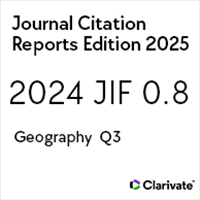Crecimiento, instituciones y convergencia en México considerando a la frontera norte
Growth, institutions and convergence in Mexico, considering the northern border
https://doi.org/10.21670/ref.2002.06.a02
Palabras clave:
Problemas económicos, crecimiento económico, convergencia económicaResumen
El presente estudio se centra en uno de los problemas económicos regionales fundamentales de nuestra época: el desenvolvimiento económico de la convergencia y el crecimiento en las regiones considerando a las instituciones. El estudio se ocupa de revisar la literatura teórica del crecimiento económico, y en particular por algunos de los desarrollos teóricos y empíricos que han tenido lugar recientemente en el campo de la convergencia económica. De igual forma, el estudio analiza la convergencia regional en México y aborda los fundamentos teóricos y empíricos en el cual las instituciones juegan un papel importante en el proceso de integración regional en México y en especial en la frontera norte. Finalmente, se realiza un análisis empírico de la convergencia regional de largo plazo para los estados de México, introduciendo una variable de corrupción dentro de las instituciones, una variable de frontera, controlando con una variable de capital humano regional. Los resultados estiman una tasa anual de convergencia de entre -0.018% a 4.1% para el periodo de 1970 a 2001, cuando se toman en cuenta los efectos de las variables institucionales, de capital humano y de frontera.Abstract The present study is focused on one of the main economic problems of our time, the study of regional economic convergence and economic growth with consideration to institutions. The study conducts a literature review on the theoretical and empirical works of economic growth, with emphasis in regional economic convergence and institutions. The empirical and theoretical analysis is centered on the regional convergence of the Mexican states taking into consideration institutional and border state factors. The empirical analysis estimates an annual rate of convergence that varies from -0.018% to 4.1% for the period between 1970 and 2001, when controlling for human capital, institutional and border effects.
Citas
Abramovitz, M. 1986. “Catching-up, forging ahead, and falling behind”. Journal of Economic History, vol. 46, núm. 2, pp. 385-406. DOI: https://doi.org/10.1017/S0022050700046209
Barro, Robert J. 1991. “Economic growth in a cross section of countries”. Quarterly Journal of Economics, vol. CVI, Mayo, pp. 407-443. DOI: https://doi.org/10.2307/2937943
Barro, Robert J. y Xavier Sala-i-Martin. 1991. “Convergence across states and regions”. Brookings Papers on Economic Activity, 1, pp. 107-182. DOI: https://doi.org/10.2307/2534639
“Convergence”. Journal of Political Economy 100(2), pp. 223-251. DOI: https://doi.org/10.1086/261816
Economic growth. McGraw Hill. New York.
Díaz Bautista, Alejandro. 2000. “Convergence and economic growth in Mexico”. Frontera Norte, vol. 13, pp. 85-110, julio-diciembre.
“An introduction to institutional change, corruption and economic growth”. Cuaderno de Trabajo, DTE 35/01. Departamento de Estudios Económicos. El Colegio de la Frontera Norte. México.
De Long, J. Bradford. 1988. “Productivity growth, convergence, and welfare: Comment”. American Economic Review, vol. 78, núm. 5, diciembre, pp. 1138-1154.
Esquivel, Gerardo. 1999. “Convergencia regional en México”. El trimestre económico, vol. LXVI, octubre-diciembre. México.
Hansen, Alvin H. 1950. “A contribution to the theory of the trade cycle”. Oxford University Press, Oxford.
Harrison, Ann. 1995. “Openness and growth: A time-series, crosscountry analysis for developing countries”. NBER Working DOI: https://doi.org/10.3386/w5221
Paper #5221.
Krugman, Paul. 1995. Development, Geography and Economic Theory. MIT Press. Massachusetts. DOI: https://doi.org/10.7551/mitpress/2389.001.0001
Krugman, Paul, Fujita y Venables. 1999. “The spatial economy: Cities, regions, and international trade”. MIT Press.
Keynes, John Maynard. 1936. “The general theory of employment, interest, and money”. Harcourt Brace. Londres.
Mankiw N. Gregory. 1995. “The growth of nations”. Brookings Papers on Economic Activity, 1:1995, pp. 275-326. DOI: https://doi.org/10.2307/2534576
Mankiw, N. Gregory, David Romer and David N. Weil. 1992. “A contribution to the empirics of economic growth”. Quarterly DOI: https://doi.org/10.2307/2118477
Journal of Economics 107(2), pp. 407-437.
Mauro, Paolo. 1995. “Corruption and growth”. Quarterly Journal of Economics 110(3); pp. 681-713. DOI: https://doi.org/10.2307/2946696
Messmacher, Miguel. 2000. “Desigualdad regional en México. El efecto del TLCAN y otras reformas estructurales”. Documento de Investigación núm. 2000-4. Dirección General de Investigación Económica. Banco de México. Diciembre, pp. 1-33.
North, Douglass C.1993. Institutions and Productivity in History. Washington University. Washington.
Olson M. 1996. “Big bills left on sidewalk: Why some nations are rich, and others poor”. Journal of Economic Perspectives, vol. 10, núm. 2, pp. 2-24. DOI: https://doi.org/10.1257/jep.10.2.3
Porter, Michael. 1990. “The Competitive Advantage of Nations”. The Free Press. DOI: https://doi.org/10.1007/978-1-349-11336-1
Romer Paul M. 1993. Two Strategies to Economic Development: Using Ideas and Producing Ideas. Proceedings of World Bank Annual Conference on Development. DOI: https://doi.org/10.1093/wber/6.suppl_1.63
Solow, R. M. 1956. “A contribution to the theory of economic growth”. Quarterly Journal of Economics, febrero, pp. 65-94. DOI: https://doi.org/10.2307/1884513
“Technical change and the aggregate production function”. Review of Economics and Statistics, 39, pp. 312-320. DOI: https://doi.org/10.2307/1926047































